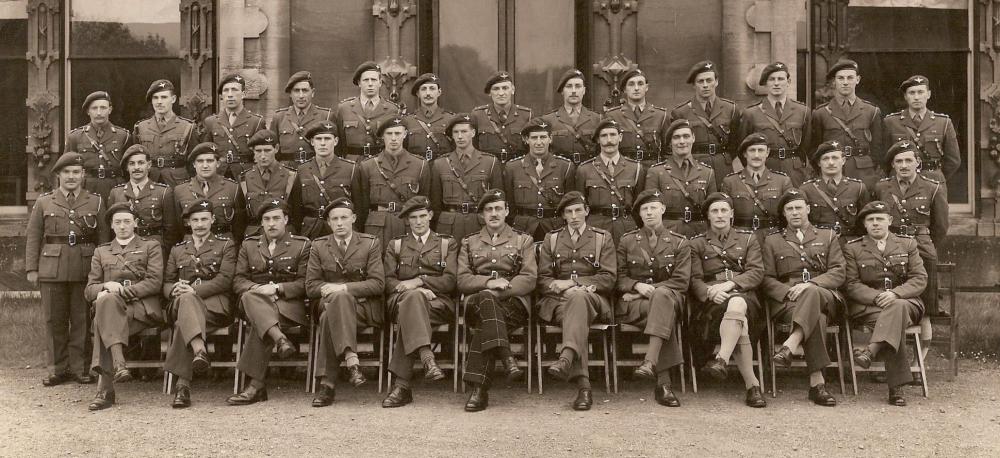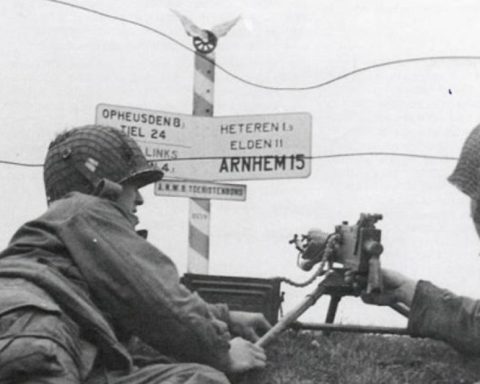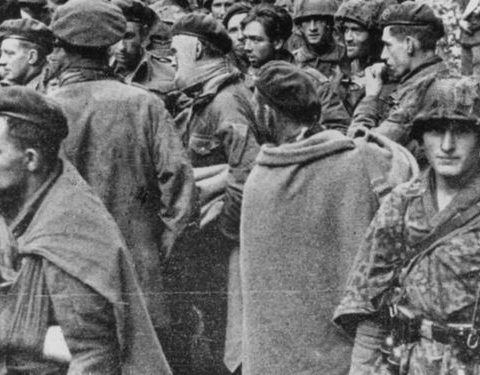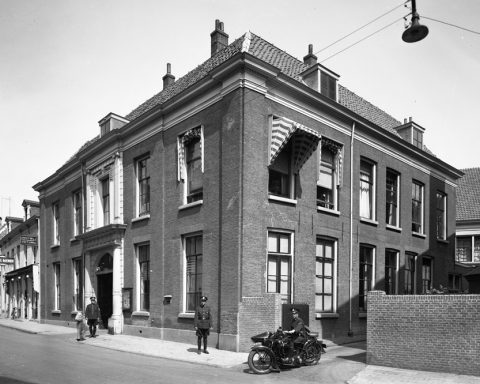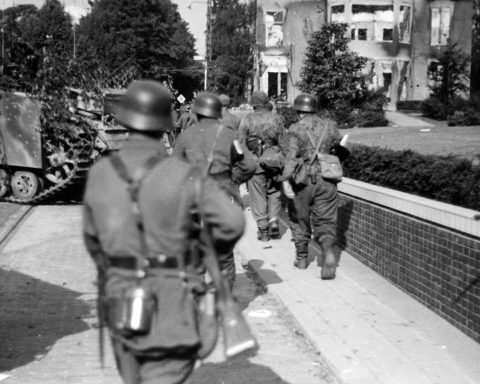Major Stanley C. Panter was one of the British paratroopers who fought at the Rhine Bridge during the Battle of Arnhem. After the war, Panter wrote an extensive battle report. In this factual and blood-curdling story of 4,000 words, Panter meticulously recounts his experiences from the airborne landings on Sunday, September 17, 1944 to the moment he was taken prisoner of war on Thursday, September 21.
Major Panter was commander of the Support Company (“S Company”) of the 2nd Battalion of the 1st Parachute Brigade under the command of Lieutenant Colonel John Frost.
We reached the landing area after an uneventful flight. The red and green lights came on and we jumped out of our plane. I was carrying a very heavy bag on my leg, which made me do a somersault, but the parachute opened completely and within seconds we had landed on Dutch soil.
My first task was to rally the M/T (motor transport) battalion that had landed by glider.
By now the sky was full of planes and parachutes as the rest of the battalion arrived. The commander used his hunting horn to lead the battalion to the meeting point. The motor transport was about a mile and a half from where I landed and I went with the motor transport to the assembly area at the battalion.
It was a very pleasant Sunday afternoon, the countryside dotted with red-roofed houses. It was a very beautiful picture marred by occasional bursts of “flak” and occasional rifle and machine gun fire from the direction of the city.
Advance to Arnhem
The battalion was already preparing to leave when I arrived. I had just enough time to load my mortars and machine guns onto the carrier and jeeps before we left. The marching order was: A Company, C Company, Battalion Headquarters, S Company.
A Company soon encountered opposition and dealt with it just as quickly. Throughout the march to the city, A Company fought several small battles and skirmishes. There were a number of casualties during the fighting.
We reached and captured the railway bridge, west of town. C Company made the attack. Unfortunately, the railway bridge was blown up by the Germans when soldiers from C Company ran onto the bridge. The explosion caused several casualties, including Lieutenant Barry.
The battalion entered Arnhem, leaving C Company to clear the right flank. By now snipers were quite active and a few casualties were incurred. I had three wounded.
There was now a gap between the rear of the battalion headquarters and the motor transport. I sped up to close the gap. I was standing in the lead bren carrier when an open armored car suddenly entered the main road from a side street and drove towards us. To my surprise I saw that it was a German armored car, full of soldiers. I opened fire with a Sten gun at close range and the armored car drove into a hedge and came to a stop.
When I examined the armored car, I counted three dead Germans and two seriously wounded, who were being treated by our medics. We continued on and overtook the battalion headquarters as they slowly passed through the outskirts of Arnhem towards our objective.
We saw evidence of A Company’s progress everywhere. Enemy dead and wounded lay around and we came across another disabled German armored car. Gunfire could be heard from several sides.
When we reached the Schipsbrug, the middle part turned out to be missing. I was ordered to halt at the Schipsbrug with two platoons until B Company arrived, whose job was to secure the Schipsbrug.
B Company had encountered stiff resistance on our left flank at the hill called Den Brink. They were still fighting their way into the city. I was also given the job of scanning the riverbank for boats.
The battalion was now spread over a fairly extensive area. A Company and the Battalion Headquarters had now reached the main objective: the Rhine Bridge. They fought there. I was at the Schipsbrug with parts of the mortar and machine gun platoons. B Company was at Den Brink and C Company had encountered stiff German resistance in the vicinity of the railway bridge.
It was now getting dark and by the time I got my defenses in order it was quite dark. My position was attacked once from the center of the city. We repulsed that attack. An enemy patrol blundered into our positions. That was also settled.
What surprised me was that the patrol came from the direction from which I expected B Company. Because it was dark, it was now easy to see where fighting was taking place in the area. The fighting was heaviest in the area around the Rhine Bridge.
A large boat suddenly emerged from the darkness downstream and approached the gap in the ship’s bridge. The boat had some lighting in the wheelhouse and I thought it might be an enemy gunboat. We had been warned that they might be patrolling the river.
After we hailed the boat there was firing so I ordered a machine gun unit to fire on the ship, which they did from about eighty yards away. They hit the boat from bow to propeller and the boat drifted to the other side of the river, where it ran onto the bank.
In the meantime we were bothered by an enemy machine gun that was positioned in a square between our position and the position near the bridge. About this time the Brigade Headquarters and the anti-tank units passed through. After they too were fired upon by the machine gun, I fired 3 inch mortars to silence them, which worked after a while.
Monday, September 18
Just after midnight the Germans opened fire again with machine guns. That led to three victims and a certain amount of excitement. After a short fire by our bren-gun section they were neutralized or packed up.
The Germans then set fire to two buildings, but I estimated that it would take until morning for the fire to reach our positions.
Around ten to three at night, B Company reached our position. They took over our position at the Schipsbrug and we moved on to the position of the Battalion Headquarters in the vicinity of the Rhine Bridge. There was occasional firing and some snipers during our advance.
I reported to the commander and he instructed me to find places for the machine guns with a clear field of fire north and east of the bridge.
My company was divided as follows: a Medium Machine Gun section sat with part of A Company in a house overlooking the bridge. One section was in reserve at our Company Headquarters, which was two houses from Brigade Headquarters. A mortar section had dug into the grass on the square of the headquarters. The remaining troops served as a rifle and bren section in one of the houses. The Assault Platoon was in position at the Battalion Headquarters.
I scouted the area surrounding the bridge for positions, but found nothing satisfactory. Moreover, I kept coming under fire from the south side of the river, where the enemy was stationed.
I picked up two glider pilots and an engineer who had gotten lost. They said they knew in which house an enemy machine gun post was located. So we gathered up a few artillery guns and their crews and headed for them.
Under cover of machine gun fire we were able to get close enough to shoot some grenades through the windows of the house. When we entered the house we discovered four dead Germans and one German who was dying. We found no machine gun. It was probably withdrawn.
As I walked back to Brigade Headquarters I saw a stream of armored personnel carriers on the bridge. This was dealt with very soundly by our six-pound guns and one of my own PIAT anti-tank units.
One of the armored cars drove off the embankment on my side, overturned and eventually caught fire when it came to rest against a wall.
There were some light mortar attacks during the day, accompanied by the rattle of machine guns and rifles. I was at Colonel Frost’s headquarters that morning when he suddenly drew his pistol and fired out the window in the direction of some Germans passing by in a truck.
Needless to say, it was a hit.
Both the machine gun section and the mortars were in full action that day. Both components achieved good results. In the evening I visited the forward positions. Things were fairly calm, but there were a lot of fires in the area. Lieutenant Douglas went out to lay anti-tank mines, which later proved very profitable. A Company and B Company conducted several patrols, encountering enemy soldiers around the bridge.
Tuesday, September 19
The firing continued throughout the night and early morning, but no determined efforts were made to dislodge the battalion. David Wallis, second in command in my company, was killed during the night.
In the morning someone managed to fix the water supply in one of my houses and food was brought in from a German truck we had taken over on a side street.
Water was quite scarce during the fighting at the bridge. All day long there was firing of all kinds of weapons and you could hear the sound of caterpillar tracks.
At the end of the morning I went out with a patrol. We saw a few armored cars, but we were unable to fire on them. Two large tanks that had surfaced were neutralized by our six-pounders and a PIAT fired by Corporal Rattray from the Assault platoon.
The six-pounders were in action almost all day and performed exceptionally, although they suffered several casualties of their own. The Germans continued to shoot new buildings on fire. At one point a plane flew over very low, but due to the thick smoke we could not see what kind of plane it was.
We received a message that the leading elements of the 2nd Army were on their way, with orders to hold on. The men were now very tired. They had had virtually no rest since Saturday evening. But morale was good.
As water and food were scarce, I ordered brandy and cigars to be distributed to all the men in the two houses under my command. This also came from the truck we had captured from the Germans.
Private Carlier of the Mortar Platoon was serving as a sniper in an alley next to the west wall of the Company headquarters. In addition to being a spotter of enemy vehicles for the crew of the six-pounder, he managed to shoot down at least nine Germans who were stupid enough to try to enter our positions from this side.
The positions had become quite dangerous by now. Ammunition was in short supply, our casualties were increasing at an alarming rate and the wounded could not be transported to a first aid station.
C Company never reached us and the 1st and 3rd Battalions could not reach us either. The remainder of the division fought against strong opposition outside the city.
Nevertheless, morale was high and the mood cheerful, even under the heaviest fire. After Lieutenant Woods fired a heavy mortar attack on German positions, Colonel Frost stopped by the mortar position to congratulate the men. As usual, Frost was immaculately dressed and wore his beret, although the entire area was under constant enemy fire.
The Assault platoon had been quite busy. They had laid anti-tank mines, shelled Germans and shelled armored cars and other vehicles. They suffered quite a few casualties.
I understood that by this time the Germans made us an offer to surrender, but they received the usual answer. The Germans then came up with a Sturmgeschütz that fired from the northeast at the headquarters of the Brigade and the battalion. We shot him with mortars.
Three mortars landed on the vehicle in a short time, killing two crew members. Before we could fire more grenades, the Sturmgeschütz disappeared. I had given instructions to the mortar section from the vicinity of the German Sturmgeschütz and not surprisingly one of the mortars landed not far from me, sending some shrapnel into my leg.
A German stuck his head above a hedge near where I was lying, but luckily I saw him first and gave him a burst from my bren gun, all for him alone.
By this time the buildings occupied by B Company were on fire. They were forced to evacuate their homes and move into one of the other buildings. One of these boys was armed with a large sword. Another had a large hunting rifle. The remainder of one of the platoons came under my command.
When night fell, little changed. So many houses were on fire that the entire area was brightly lit. I withdrew the mortar teams and set up a system that allowed some of the soldiers under my command to sleep briefly in a darkened room.
The house next to us caught fire that night and burned down. I had men ready in the attic of our building with sand and bags to prevent the fire from spreading. All in all, the fire kept us busy all night.
Wednesday, September 20
At sunrise we were ready, but we were not attacked. However, shots were still being fired at our positions.
During the morning we were under heavy fire. The roof and top floor of my Company’s headquarters had been blown away. I had some men build trenches in the garden. This gave us an alternative position to take if necessary.
With some empty wine bottles and oil we made some Molotov cocktails that we could use against German vehicles. One of the mortars was destroyed, killing Sergeant McCreath and Private Crew. Lieutenant Woods was seriously injured.
I now had one mortar left that I could use. Sergeant Jackman remained in action until all ammunition for the mortars was used up. We managed to take out two more machine gun positions, an anti-tank gun and a vehicle.
Late in the afternoon the remnants of A Company were withdrawn to the Battalion Headquarters area. A Company had been fighting heavily from the moment they landed and had suffered heavy casualties. All the officers were wounded and Lieutenant Grayburn was wounded twice before he was finally killed.
I had to reorganize my defenses to prevent the enemy from easily infiltrating our positions. A patrol was sent out to see if we could move into other buildings. Two men were injured while crossing the square.
I visited Battalion Headquarters and found most of the men in trenches. The position in the building had become untenable. The Germans started a heavy artillery bombardment in the afternoon. Both Colonel Frost and Major Crawley were wounded in the leg.
Around three o’clock in the afternoon the Germans’ fire concentrated on my headquarters. After the south-west corner of the building had been blasted away with artillery shells, the German artillery focused on the house of B Company and the building of the Brigade Headquarters. I reconnoitered the area to the northeast of our position, as that seemed the best direction to divert if necessary.
In one of the streets there was a woman moaning on the street. Her jaw had been blown off. While we were giving the woman some morphine, the Germans fired at us with machine guns. The whole area was a mess, with dead Germans and pieces of equipment everywhere.
I ordered a Bren section to take up position to my right. There they shot to pieces a German patrol that happened to be advancing along that side. At least seven Germans were shot.
The house in which B Company was located was now also on fire. The troops led by Captain Hoyer-Millar had evacuated the building and taken up positions in the garden.
The German artillery was now once again aimed at my headquarters. The front was blown out and the top was on fire. I stopped by Battalion Headquarters to request permission to evacuate, which was given by Major Tatham-Warter. He had now taken command of the battalion.
We evacuated just in time. The artillery fired on the ground floor while at the same time machine guns were also fired at the windows. I returned to the ground floor once more for a final check when there was a blinding flash of light. I don’t remember anything until I came to in a trench outside the building, where I had been dragged by one of the officers.
It seemed that I had arrived at the ground floor at the same time with an 88mm grenade. I almost died, but I was lucky.
We were fairly well dug into the garden. I had a Vickers machine gun including a team at my disposal, which covered the square.
Just after taking up our new position, we received word that the 2nd Army would arrive in the Rhine Bridge area shortly after five o’clock that afternoon. This was contradicted shortly afterwards and we were told we would have to hold out until the next morning.
All buildings in the area, with the exception of two smaller buildings, were on fire at the time. We were under constant fire from light and heavy weapons, mortars, artillery and tanks. There were many casualties.
I received instructions to report to battalion headquarters. When I arrived in the garden of the headquarters I saw that positions were being hastily taken up in the garden.
Colonel Frost had agreed to a half-hour ceasefire to evacuate the wounded. The wounded were removed with the help of German medics. Unfortunately, Colonel Frost was also taken away.
The removal was only intended for the wounded, but the Germans tried in their usual dirty way to remove other soldiers as well. This was stopped by Captain Hoyer-Millar.
Major Tatham-Warter had refused to surrender the battalion. Everyone who was still able to fight gathered around the battalion headquarters. I moved my men, now considerably reduced, and took up positions.
After the ceasefire ended, the situation in the garden was indescribable. What was left of the battalion formed a square around the headquarters yard and was surrounded on all sides by Germans, who continued to fire grenades at our positions.
The entire area was illuminated by the buildings that were on fire. The Germans kept shouting for us to surrender, but the men just cursed in response and invited the Germans to come over and catch us.
I think that was the battalion’s finest hour, because I think at that moment everyone thought death was inevitable. All ranks were determined to do as much damage as possible before that happened.
After about an hour I was ordered to return to my old positions. The battalion would try to break out. The entire battalion crossed the street and took up positions in a two-story building, a warehouse and a garden. I used the opportunity to booby trap my jeep and the German truck.
In the smoke and chaos we hoped that we had left our positions unnoticed, because the Germans were still concentrating their fire on our old positions. But because that hope was doubtful, it was decided to move on towards the city center.
We ran through the ruins of the burnt out buildings led by the commander, myself and two Bren gunners. After finding our way through some side streets in the twilight, we reached another square.
An armored car passed by, but we were not seen. We continued until I was seen by a German soldier. He opened fire and there were a few casualties. I ducked into an alley on the right. From the alley I threw a grenade in the direction of the gunfire and wanted to rejoin the men who had taken cover among the ruins.
The men had now dispersed. I joined a group of men led by our commanding officer. We entered a building that was probably a municipal office and together with the commander I explored the top floor.
When he was about to go down the stairs, he was confronted by a German at the bottom of the stairs. The German fired his automatic rifle, but did not hit anyone. I threw down my last grenade and then we rejoined the rest of the group.
The commander decided that we would remain on the ground floor until sunrise. With the exception of a few guard posts, everyone was given the opportunity to rest. Our group now consisted of the commander, the adjutant, Captain Hoyer-Millar with a number of soldiers from his company, Lieutenant Tannenbaum with a few of his men and my own group of about nine men.
Thursday, September 21
There were a number of heavy mortar attacks that night. Later I heard that they came from the guns of the 2nd army.
At one point when I looked outside at night, I saw about 25 men. I collected them in our building. Among the men were Sergeant Jackman and some men from A Company and B Company. We decided it was better to wait until we were relieved by the 2nd Army. There were Germans all around us.
Captain Hoyer-Millar and myself took shelter in some sort of vault. After settling in, we made plans on how to make things difficult for the Germans after they withdrew from the area. We had no doubt that we would be relieved by the 2nd Army that morning.
After a while we heard a huge scream nearby. They turned out to be German SS men who had already captured many of our men. When the Germans entered the room where we were hiding, we were standing flat against the wall. In the dark they did not see us and we were not discovered.
Captain Hoyer-Millar and I stayed put for a few more hours while we figured out what we were going to do. Shortly afterwards, the building where we were located was searched again by Germans. We decided to get out of there, but we ended up in a room with no exit. When we looked for another way out, we discovered that we were being held at gunpoint by three automatic pistols.
This was it. We were taken to SS headquarters for interrogation. The SS gave us no chance to escape. There was always a German holding us at gunpoint.
As we were taken away through Arnhem, I had a chance to see what damage we had done. Everywhere we had fought there were wrecked vehicles and bodies.
I was taken to some headquarters on the other side of town. There, all the things I had with me were taken from me. From this headquarters I was taken along with a number of other wounded on a horse and cart to a hospital.
The hospital was hit by an artillery shell that night. I took advantage of the chaos by walking outside unnoticed. When it got light I hid in a chicken coop in a garden. When it got dark again I gave it a try.
I reached the river towards morning and decided to take shelter on one of the boats. But just as I turned a corner, I bumped into a German soldier standing there smoking. I was immediately held at gunpoint while he called his colleagues.
The Germans bandaged my wounds and gave me dark bread with German sausage, along with a few sips of wine and some cigarettes.
Post Scriptum
Stanley Panter was transferred by the Germans to the prisoner of war camp Oflag XIIB and later transferred to Oflag 79 in Braunschweig. There he was liberated by the American 9th Army in April 1945.

